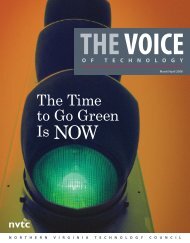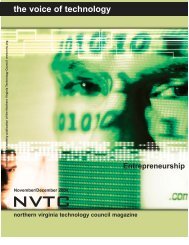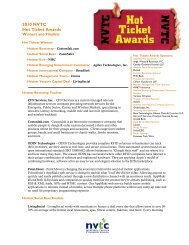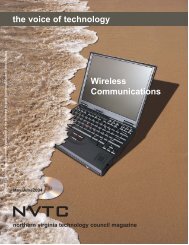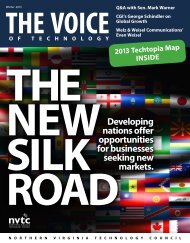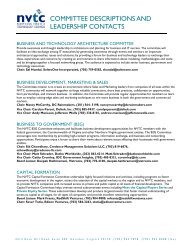Fall 2010 - Northern Virginia Technology Council
Fall 2010 - Northern Virginia Technology Council
Fall 2010 - Northern Virginia Technology Council
Create successful ePaper yourself
Turn your PDF publications into a flip-book with our unique Google optimized e-Paper software.
P E R S P E C T I V E S<br />
Mobile Computing—Collaborative, Engaging and Always On<br />
A New Paradigm for Customer Engagement<br />
By Bradley Schwartz<br />
In a revolution would you lead, observe or put<br />
your head in the sand and hope it passes?<br />
We are in a revolution — a mobile revolution<br />
where mobile technology and computing<br />
platforms will fundamentally change how business<br />
and governments serve its customers. Mobile<br />
brings the advantages of cloud computing<br />
together with social networking while providing<br />
convenient access to information from any<br />
source, device or location, at any time.<br />
The mobile technology revolution began 40<br />
years ago and has evolved today where nine out of<br />
10 Americans have a mobile device. With access<br />
to the Internet using powerful mobile computing<br />
platforms, we have reached the next adoption<br />
wave transforming how we communicate, work<br />
and play. The market trends around mobile technology<br />
are unmistakable in foretelling the future:<br />
• In Q4 of <strong>2010</strong>, the number of smartphones and<br />
tablets sold exceeded the number of PCs sold.<br />
• In 2011, more than 50 percent of people accessed<br />
Facebook and Twitter via smartphones.<br />
• By 2012, one in every two Americans will have<br />
a smartphone (in Japan the penetration is 86<br />
percent).<br />
• By 2014, more people will connect to the Internet<br />
via mobile devices than PCs.<br />
Apple sparked the current mobile Internet<br />
adoption wave with the introduction of the iPhone,<br />
iTouch, iPad and the Apple AppStore. Today’s<br />
mobile applications actively push the latest<br />
trends and best deals to the palm of the consumer<br />
in real-time. Consumer desires are indulged with<br />
transparent pricing, consumer-driven product<br />
reviews and services providing deep discounts<br />
using mobile coupons. Consumption models are<br />
evolving as people become accustomed to buying<br />
soft drinks and paying parking meters with<br />
their mobile device. This is just the beginning of<br />
the new engagement model where every touch<br />
point is interactive, engaging or relevant to our<br />
personal interests.<br />
What will Drive the Next Adoption Cycle?<br />
The third wave in the mobile revolution will occur<br />
when business and government fully embrace<br />
the mobile engagement model. While 53<br />
percent of corporations have adopted or support<br />
iPhones, only 3 percent of the apps provide utility<br />
to business or government. The paradigm<br />
shift will occur when mobile apps are deployed<br />
to increase efficiency, make relevant information<br />
more accessible and engage the workforce to<br />
be more creative, collaborative and personal to<br />
their job function. With a highly mobile customer<br />
base and community, new models will evolve<br />
that provide a more relevant and engaging interaction<br />
further blurring the lines between work<br />
and personal life. How we interact with employees<br />
and how we engage with customers will never<br />
be the same.<br />
Unfortunately Every Revolution has its Challenges.<br />
Igniting government and corporate enterprises<br />
to take full advantage of the mobile engagement<br />
model has four primary challenges:<br />
1. Information security and data privacy<br />
2. Adoption and resistance to change<br />
3. Separating personal and business usage<br />
4. Who pays for devices, access and<br />
mobile app development<br />
Future Mobile Computing Predictions<br />
1. Branded Mobile Apps will become commonplace.<br />
Similar to the late ‘90s when every<br />
business needed a website to be deemed<br />
credible, every agency or business will need a<br />
branded mobile app to be deemed relevant.<br />
2. Every agency or business will have their<br />
own application store or repository. Workers<br />
will go to the company “AppStore” to download<br />
applets on their mobile device to improve<br />
productivity, encourage collaboration and better<br />
filter relevant information.<br />
3. We will overcome the challenges. By combining<br />
technology, policy changes and human<br />
resource incentive, technology companies will<br />
come together to remove obstacles and lead<br />
the third wave to realize the full potential of<br />
the mobile revolution.<br />
The question remaining is whether the <strong>Northern</strong><br />
<strong>Virginia</strong> technology community is ready to lead<br />
the mobile technology revolution and transform<br />
how we engage our workforce, customers and<br />
community. nvtc<br />
“The new mobile<br />
engagement model<br />
will be collaborative,<br />
engaging, always on<br />
and highly personalized.<br />
How organizations<br />
interact with the<br />
workforce and how they<br />
engage with customers<br />
will never be the same.”<br />
Bradley Schwartz is president<br />
and ceo of Blue canopy, one of<br />
the fastest-growing government<br />
system integrators. As a 2011 Tech<br />
Titan and nvTc Board Member,<br />
Brad has a natural talent to lead<br />
and grow companies.<br />
<strong>Fall</strong> 2011 www.nvtc.org THE VOICE OF TECHNOLOGY 5



